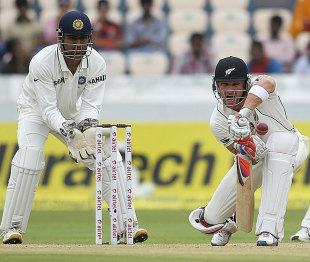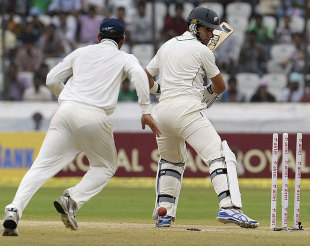August 29, 2012

| |||
After losing 2-0 to a weedy West Indian side, New Zealand slumped to an innings defeat in their first Test in India. It would take a brave man to put his money on them in the second Test in Bangalore. The loss in Hyderabad only underlined the gap between New Zealand and the major Test-playing nations.
Over the years though, New Zealand had gained the reputation of a team that always punched above their weight. Their courage and the never-say-die attitude made up for the lack of the skills needed to excel in different conditions.
On their tour of India in 2003-04, which was my debut series, New Zealand drew both Test matches, and even had India follow on in Mohali. They were routed in the ODIs when they visited in 2010-11, but secured two draws in the three-Test series. They have rarely won in India but haven't surrendered before as feebly as they did in Hyderabad, and that must hurt their fans. The pitch deteriorated a lot faster than many expected it to and had enough in it for the spinners from the second day, yet it was far from being unplayable.
Susceptibility to pace and bounce tends to get far more attention than weakness against spin. That's perhaps because, unlike pace bowlers, spinners don't pose a physical threat but the truth is that being bamboozled by spin can cause long-lasting mental scars.
With the second Test only two days away, New Zealand must be working overtime to find ways to counter India's potent spin threat. Here are a few things their batsmen should keep in mind while taking on R Ashwin and Pragyan Ojha in Bangalore.
Decisive footwork
Read the ball from the hand, not from the pitch, because it will give you a little more time to react. Use both feet to either get to the pitch of the ball with a long forward stride or to go deep inside the crease to shorten the length. Spinners are at their most dangerous when the batsman refuses to get to the pitch of the ball to smother the lateral movement off the surface. That's what New Zealand did in Hyderabad. Most of their batsmen were rooted to the crease and offered unconvincing forward prods to everything that was pitched up, in hope that the ball would find the middle of the bat. Their shots lacked conviction and resulted in many bat-pad catches. Some New Zealand batsmen started shuffling to counter the spin, but little did they realise that sideways movement within the crease can only be effective against fast bowlers because it helps you play in the second line. Only a decisive forward-and-backward movement can save the day against spinners. In England, Hashim Amla did that beautifully against Graeme Swann.
Read the ball from the hand, not from the pitch, because it will give you a little more time to react. Use both feet to either get to the pitch of the ball with a long forward stride or to go deep inside the crease to shorten the length. Spinners are at their most dangerous when the batsman refuses to get to the pitch of the ball to smother the lateral movement off the surface. That's what New Zealand did in Hyderabad. Most of their batsmen were rooted to the crease and offered unconvincing forward prods to everything that was pitched up, in hope that the ball would find the middle of the bat. Their shots lacked conviction and resulted in many bat-pad catches. Some New Zealand batsmen started shuffling to counter the spin, but little did they realise that sideways movement within the crease can only be effective against fast bowlers because it helps you play in the second line. Only a decisive forward-and-backward movement can save the day against spinners. In England, Hashim Amla did that beautifully against Graeme Swann.
Pushing the fielders back
On turning pitches, you must be aggressive, for no matter how good your defensive technique, the odd ball will turn and jump unexpectedly to abruptly end your stay. If you only concentrate on defending, as New Zealand did in the second innings, the spinners won't feel threatened and will continue to flight the ball. To extract optimum spin and bounce off the surface, spinners must give the ball some air. This becomes easier if the batsman has gone into a shell. All quality players of spin take the aerial route really early in the innings, because it forces the bowler to not only push the fielders back but to also cut down on flighting the ball. Once the fielders are pushed back, batsmen find it easier to rotate the strike, and the moment a spinner starts bowling flatter, he plays into your hands. MS Dhoni did it efficiently against Jeetan Patel the moment he walked in to bat in Hyderabad.
On turning pitches, you must be aggressive, for no matter how good your defensive technique, the odd ball will turn and jump unexpectedly to abruptly end your stay. If you only concentrate on defending, as New Zealand did in the second innings, the spinners won't feel threatened and will continue to flight the ball. To extract optimum spin and bounce off the surface, spinners must give the ball some air. This becomes easier if the batsman has gone into a shell. All quality players of spin take the aerial route really early in the innings, because it forces the bowler to not only push the fielders back but to also cut down on flighting the ball. Once the fielders are pushed back, batsmen find it easier to rotate the strike, and the moment a spinner starts bowling flatter, he plays into your hands. MS Dhoni did it efficiently against Jeetan Patel the moment he walked in to bat in Hyderabad.
To many batsmen the sweep shot is the only attacking response to the turning ball. But they must understand that they'll get the right balls to sweep only after forcing the bowler to bowl flatter and shorten his length by stepping down the track regularly. Wait for the bowler to release the ball so that he can't alter his length or line, and advance against balls that go higher than the eye level.

| |||
Since spinners bowl a lot slower than the quicks, it's tempting to reach for the ball. But if you're defending, you must resist the temptation and allow the ball to come to you, as you would when facing a fast bowler. Once you have allowed the ball to come to you, play it as delicately as possible with soft hands. Let the top hand remain firm while barely holding the bat with the bottom hand.
It's imperative to transfer the body weight at the right time. Whether you are defending or playing an aggressive shot against a spinner on a turning pitch, if you transfer your weight a fraction earlier, you will commit yourself to the stroke and struggle to play the ball along the ground. And if you are a fraction late, you won't get any power in your shots.
Playing the turning ball on a crumbling pitch requires just as much expertise as playing the moving ball on a fast and bouncy pitch. Even after taking a crash course in playing the turning ball, New Zealand may not be able to avert defeat, but it's worth using every ounce of their energy to at least delay the inevitable.